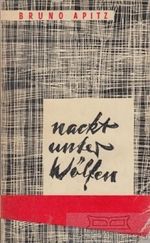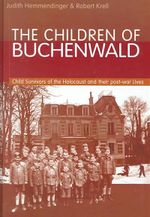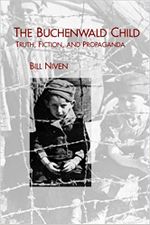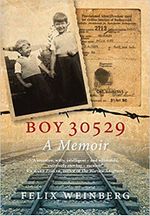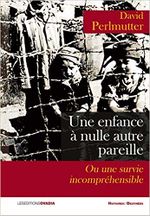Category:Buchenwald (subject)
Buchenwald was a concentration camp in Germany. It was built mainly to accommodate political prisoners, but in the last months of a war a lot of inmates from concentration camps in the East (including children) were taken to Buchenwald.
The Buchenwald Boys
When the U.S. Army liberated Buchenwald on April 11, 194, they found 21,000 inmates, of which 904 children. They were mostly adolescents; only around 30 of them were under 13.
Buchenwald was a labor camp for political prisoners, not an extermination camp for Jews. During the last year of the war, however, the Nazis began sending large numbers of Eastern European Jews to Buchenwald (including children) as a result of their failing war efforts. The children survived at Buchenwald because the political prisoners who ran the camp protected them, isolating them in a special barrack (Block 66), and other barracks.
The establishment of the children’s block was led by Antonin Kalina, a Czech communist prisoner. Kalina, with the help of other political prisoners, was able to persuade the SS at Buchenwald to let them create a block for the new influx of adolescents coming in from the East. The block used for the children was conveniently located in the corner of the little camp, ensuring that it was as far away from the Nazi’s watch as possible.
Every block had what was called a “block elder” who was responsible for ensuring that the inmates of their block went to roll-call, followed orders, did their work, and kept up with their daily tasks.[1] The block elder of Block 66 was Kalina, and he is primarily responsible for saving the lives of the 900 boys living in Block 66.
While conditions were not great anywhere in the camp, for the children of Block 66, they were slightly better. Unlike adults, most children could not fend off the disease, hunger, and physical and psychological trauma as well. Adults, specifically the communist prisoners directly tried to help the children. The other prisoners in Buchenwald did all that they could in their power to try and protect the children from the SS, and as the war was clearly ending, from being taken out on death marches.[8] Men would also give extra food to these starving boys and share packages from The Red Cross with them. Had there not been Block 66, most of these children would have perished in the camp.
The children were not made to work in the camp, as most were too weak and young to do any actual labor. During the days, when it was possible, the children were taught songs in Yiddish and told stories by some elders and older children to keep them occupied and filled with hope for the outside world.
Additionally, Kalina, to help protect the children in the barrack, made them change clothes, so as not to be dressed as Jews, and changed the Jewish sounding names of the boys, so that when the SS officers came by looking for Jews, he could tell them that there were none in his block
Most of the children were originally from Poland, though others came from Hungary, Slovenia and Ruthenia. Unsure of what to do with the child survivors, American army chaplains, Rabbi Herschel Schacter and Rabbi Robert Marcus, contacted the offices of the OSE (Oeuvre de Secours aux Enfants), the Jewish children's relief organization in Geneva. They arranged to send 427 of the children to France, 280 to Switzerland and 250 to England. [Vivette Samuels reverses the figures for England and Switzerland in her monograph, "Sauver les Enfants."] On June 2, 1945 OSE representatives arrived in Buchenwald, and together with Rabbi Marcus escorted the transport of children to France. Rabbi Schacter accompanied the second transport to Switzerland. Because of the difficulty in finding clothing for the children, the boys were clad in Hitler Youth uniforms. This created a problem, for when the train crossed into France, it was greeted by an angry populace who assumed the train was carrying Nazi youth. Thereafter the words "KZ Buchenwald orphans" were painted on the outside of the train to avoid confusion.
On June 6, 1945 the French transport arrived at the Andelys station and the orphans were taken to a children's home in Ecouis (Eure). The home had been set up to accommodate young children, but in fact only 30 of the boys were below the age of 13. This was only one of the many problems faced by the OSE personnel, who were not prepared to handle a large group of demanding, rebellious teenagers who were full of anger for what they had experienced. At Ecouis the boys were given medical care, counseling and schooling until more permanent accommodations could be found. Most of the children remained only four to eight weeks at Ecouis before being moved elsewhere, and the home was closed in August 1945.
Among the first to leave were a group of 173 children who had family in Palestine. They were given immigration certificates and departed from Marseilles in July aboard the British vessel, the RMS Mataroa. The remaining boys at Ecouis were soon transferred to other residences and homes. Some of the older ones were sent to the Foyer d'Etudiants located on the rue Rollin in Paris, where they boarded while attending vocational training courses or working at jobs in the city. Others were sent to the Chateau de Boucicaut home in Fontenay-aux-Roses (Hauts-de-Seine). Many of the boys came from religiously observant homes. Since the OSE could not obtain kosher food for everyone, they divided the children into religious and non-religious groups. Dr. Charly Merzbach offered OSE the use of his estate, the Chateau d'Ambloy (Loir-et-Cher) for the summer, and between 90 and 100 boys chose to go there in order to receive kosher food and live in a religious environment. In October 1945 the children and staff of Ambloy were relocated to the Chateau de Vaucelles in Taverny (Val d'Oise). About 50 of the non-religious boys were taken to the Villa Concordiale in Le Vesinet (Yvelines) near Paris that housed an equal number of French Jewish orphans. In the summer they went to the Foyer de Champigny in Champigny-sur-Marne (Val-de-Marne). In all the homes attended by the Buchenwald children vocational training as well as regular classroom instruction was offered. At the same time OSE social workers made every effort to locate surviving relatives, succeeding in about half the cases. By the end of 1948 all of the Buchenwald children who had come to France had left the OSE fold and begun new lives for themselves.
Literature
1958
Nackt unter Wölfen (Mitteldeutscher Verlag, 1958) is a semi-biographical novel, written by Holocaust survivor Bruno Apitz (1900-1979).
ET : Naked Among Wolves, translated by Edith Anderson (Berlin: Seven Seas Publishers, 1960).
The novel tells the story of prisoners in the Buchenwald concentration camp who risk their lives to hide a young Polish-Jewish boy. Apitz himself had been imprisoned in Buchenwald as a communist from 1937 to 1945. The boy, whose name in the novel is Stefan Cyliak, was revealed to be based on Stefan Jerzy Zweig after publication of the novel.
Translated into over 30 languages, winning worldwide recognition.
Adapted three times for a film--in 1960, 1963, and 2015.
1984
Les enfants de Buchenwald: que sont devenus les 1000 enfants juifs sauvés en 1945? (Lausanne: Favre, 1984) is a book by Judith Hemmendinger.
ET : The Children of Buchenwald: Child Survivors and Their Post-War Lives (2000) revised and edited by Robert Krell (Jerusalem and Hewlett, NY: Gefen House, 2000).
"Some of the 426 child survivors of Buchenwald tell their stories, from their lives in the camp, their liberation, and their struggle for normalcy and emotional well-being."--Publisher description.
From Auschwitz to Liberation -- Arrival in France -- The children at Ambloy -- Lulek's story -- Romek's story -- Taverny -- Destinations- leaving Taverny -- Life journeys- 20 years later in New York -- Life journeys- France -- Life journeys- Israel -- Elie Wiesel -- Observations and conclusions.
Robert Krell is a Dutch child survivor and psychiatrist living in British Columbia.
Judith Hemmendinger worked with many of the boys during their early period of transition in France.
1996
Saving Children: Diary of a Buchenwald Survivor and Rescuer (London: Weidenfeld & Nicolson, 1991) is a book by Holocaust survivor Jack Werber (1914-2006), with William B Helmreich.
"This is a remarkable story of survival, resistance, and courage. Jack Werber spent five and a half years in Buchenwald, one of Hitler's most notorious concentration camps. More than 56,000 inmates were put to death there and, out of 3,200 Polish prisoners who entered the camp together with Werber, only eleven were alive by war's end. Of those, he was the only Jew ... But Werber did more than survive; he helped others survive. In what is truly one of the most amazing stories to come out of the Holocaust, Jack Werber helped to save the lives of some 700 Jewish children who had arrived at Buchenwald in late 1944. Shortly before that Werber had learned that his entire family his wife, daughter, parents, and seven brothers and sisters had all been murdered by the Nazis. "There was no reason to go on," he had thought, but seeing the children transformed his outlook. He resolved to do everything in his power to prevent them from meeting his daughter's fate ... Werber is one of the very few Jews to belong to the camp underground. Together with several other Jews, he made saving children his special mission. At great personal risk, he arranged for them to be hidden in various barracks and to be given false working papers. Incredibly, he and his group actually started a school where the children studied Jewish history, music, and the Hebrew language. These activities gave the youngsters hope that they might survive and ultimately most of them did ... This story of resilience and courage has never been told before, despite the thousands of books that have appeared about the Holocaust. In Saving Children, we learn how it was achieved. Werber describes in fascinating detail what life in Buchenwald was like, providing much new information about the daily struggle for existence that characterized life in the camp. Above all, he shows how it was possible to remain human and to act with compassion, even in the face of enormous cruelty and barbarism."--Publisher description.
2007
The Buchenwald Child: Truth, Fiction, and Propaganda (Rochester, NY: Camden House, 1991) is a book by William John Niven.
"At the notorious Buchenwald concentration camp, communist prisoners organized resistance against the SS and even planned an uprising. They helped rescue a three-year-old Jewish boy, Stefan Jerzy Zweig, from certain death in the gas chambers. After the war, his story became a focus for the German Democratic Republic's celebration of its resistance to the Nazis. Now Bill Niven tells the true story of Stefan Zweig: what actually happened to him in Buchenwald, how he was protected, and at what price. He explores the (mis)representation of Zweig's rescue in East Germany and what this reveals about that country's understanding of its Nazi past. Finally he looks at the telling of the Zweig rescue story since German unification: a story told in the GDR to praise communists has become a story used to condemn them."--Publisher description.
William John Niven, Professor of Contemporary German History at the Nottingham Trent University, UK.
2011
Out of the Depths: The Story of a Child of Buchenwald Who Returned Home at Last (New York: Sterling Pub.: In conjunction with OU Press, 2011) is the memoir written by Holocaust survivor Yisrael Meir Lau (b.1937).
KEYWORDS: <Poland> <Buchenwald>
"Israel Meir Lau, one of the youngest survivors of Buchenwald, was just eight years old when the camp was liberated in 1945. Descended from a 1,000-year unbroken chain of rabbis, he grew up to become Chief Rabbi of Israel--and like many of the great rabbis, Lau is a master storyteller. Out of the Depths is his harrowing, miraculous, and inspiring account of life in one of the Nazis' deadliest concentration camps, and how he managed to survive against all possible odds. Lau, who lost most of his family in the Holocaust, also chronicles his life after the war, including his emigration to Mandate Palestine during a period that coincides with the development of the State of Israel. The story continues up through today, with that once-lost boy of eight now a brilliant, charismatic, and world-revered figure who has visited with Popes John Paul and Benedict; the Dalai Lama, Nelson Mandela, and countless global leaders including Ronald Reagan, Bill and Hillary Clinton, and Tony Blair."--Publisher description.
Yisrael Meir Lau (Poland, 1937)
2012
Kinderblock 66: Return to Buchenwald (USA, 2012) is a documentary directed by Rob L. Cohen, featuring four Holocaust child survivors: Israel Laszlo Lazar (Romania, 1930), Pavel Kohn (Czechia, 1929), Alex Moskovic (Slovakia, 1931), and Naftali Furst (Slovakia, 1933).
- Available online: UM Libraries
"Kinderblock 66 is the story of four men who, as young boys, were imprisoned by the Nazis in the notorious Buchenwald concentration camp and who, sixty-five years later, return to commemorate the sixty-fifth anniversary of their liberation. The film tells the story of the effort undertaken by the camp's Communist-led underground to protect ad save Jewish children who were arriving in Buchenwald toward the end of the Holocaust. Kinderblock 66 also tells the story of Antonin Kalina, the head of the block who was personally responsible for saving 904 boys in Buchenwald."--Publisher description.
Rob L. Cohen, filmmaker.
2013
Boy 30529: A Memoir (London & New York: Verso, 2013) is the memoir written by Holocaust survivor Felix Weinberg (1928-2012).
KEYWORDS: <Czechoslovakia> <Theresienstadt> <Auschwitz> <Buchenwald>
"In 1939 twelve-year-old Felix Weinberg fell into the hands of the Nazis. Imprisoned for most of his teenage life, Felix survived five concentration camps, including Terezin, Auschwitz, and Birkenau, barely surviving the Death March from Blechhammer in 1945. After losing his mother and brother in the camps, he was liberated at Buchenwald and eventually reunited at seventeen with his father in Britain, where they built a new life together. Boy 30529 is an extraordinary memoir of the Holocaust, as well as a moving meditation on the nature of memory.."--Publisher description.
Felix Weinberg (Czechia, 1928-2012)
2019
Une enfance à nulle autre pareille (2019) is the memoir written by Holocaust survivor David Perlmutter (1937).
KEYWORDS: <Poland> <Lodz Ghetto> <Buchenwald> <OSE Orphanage>
"Dès 1994, le regretté Jorge Semprun écrivait dans son livre L'ECRITURE OU LA VIE qu'un jour, relativement proche, il n'y aura plus aucun survivant de Buchenwald pour dire et raconter d'une manière directe, ce qu'a été la survie dans un camp de concentration nazi. Aujourd'hui, presque 25 ans après, ce livre est un des derniers témoignages, sinon peut-être le dernier, à rassembler des souvenirs personnels ainsi que des faits racontés par des adultes dignes de foi, d'un enfant juif qui a survécu à des années de ghetto, puis d'un camp de travail, enfin, d'un camp de concentration, et qui a été libéré à tout juste 8 ans."--Publisher description.
David Perlmutter (b.1937) was born on 8 April 1937 in Lodz. Grew up in the Lodz Ghetto. Deported to Buchenwald. He was one the youngest child Holocaust survivors at Buchenwald. At the OSE orphanage in France, David formed a strong bound with Yisrael Meir Lau and Izio Rosenman. David would remain in France all his life.
Child survivors
- Israel Laszlo Lazar (Romania, 1930) -- arrived on Feb 6, 1945 (15 yo)
- Pavel Kohn (Czechia, 1929-2017) -- Feb 10, 1945 (15)
- Alex Moskovic (Slovakia, 1931-2019) - Jan 26, 1945 (13)
- Naftali Furst (Slovakia, 1933) -- Jan 23, 1945 (12)
Non-identified children
Zysio Abramovicz, <Abram Czapnik>, Albert Dymant, Joseph Fachler, Léon Frydman, Moritz Freilich, Idek Goldmann, Lejzor Grunberg, Israel Grojsman, Jakob Kapelusz, Mayer Kilsztok, Léon Lewkowicz and Hersch Unger.
<Abram Chapnik>, Henri and Albert Dymant, Jozef Dziubak, <Salek Finkelstein>, <Wolf Fojgel>, Idel Goldblum, Jochan Goldkrantz, <Jakob Kapelusz>, Nachman Klugmann, Max Kozuch, Manfred Lewin, <Theodore Lowy>, Szymk Michalowicz, Hans Oster, Salek Rotschild, Salek Sandowski, Abram Schilcott, Jozef Schwarczberg, Moniek Solarz, Hersch Unger, Usher, Ivar Segalowitz, Moishe Shapiro, <Romek Wajsman> and Lolek Weinstein
- Joe Majer = Salomon Majer
- Philip Kanner = Fajwen Kaner
- Jerry Kapelus = Jakob Kapelusz
- Ted "Booby" Lowy (Lewy) = Theodor Lowy
- Eddy Balter = Elias Balter
- Willy Fogel = Wolf Vogel / Wolf Fojgel
- Max Kosuch
- Robbie Waisman = Romek Wajsman
- Leon Friedman
- Szaja Chaskiel
Nathan Swarc, <Romek Wajsman>, Leon Friedman, Hershel Ungar (Unger), Jakob Kapelusz, Beniek Mrowka
Abram Gzapnik, Herchel Unger, Joseph Fachler, Marek Lozinski, Heersh Linger
Yossl Baker, Henry Salter
Pages in category "Buchenwald (subject)"
The following 119 pages are in this category, out of 119 total.
1
- Rudi Dingfelder / Robert Felder (M / Germany, 1924-1986), Holocaust survivor
- Milo Adoner (M / France, 1925-2020), Holocaust survivor
- Chaim Aizen
- Gabriel Birkenwald (M / Belgium, 1926), Holocaust survivor
- Jehoszua Cygelfarb
- Arnost Lustig (M / Czechia, 1926-2011), Holocaust survivor
- Herschel Wajchendler / Harry Wajchendler (M / Poland, 1926-2005), Holocaust survivor
- Simcha Applebaum (M / Belarus, 1927), Holocaust survivor
- Bill Basch
- Shaul Bekierman
- Moniek Bergermann / Monty Bergerman (M / Poland, 1927-2010), Holocaust survivor
- Henri Borlant (M / France, 1927), Holocaust survivor
- Sabatino Finzi (M / Italy, 1927), Holocaust survivor
- Jack Gruener
- Menachem Haberman
- Mendel Herskovitz (M / Poland, 1927), Holocaust survivor
- Wolf Himmelfarb / William Himmelfarb (M / Poland, 1927-2003), Holocaust survivor
- Harry Olmer / Chaim Olmer (M / Poland, 1927), Holocaust survivor
- Jakob Rybsztajn / Jacques Ribons (M / Poland, 1927-2016), Holocaust survivor
- Leon Rytz (M / Poland, 1927), Holocaust survivor
- Zwi Steinitz (M / Poland, 1927), Holocaust survivor
- Léon Zyguel (M / France, 1927-2015), Holocaust survivor
- Jacob Ajzenberg / Jack Ajzenberg (M / Poland, 1928), Holocaust survivor
- Icek Alterman
- Shlomo Binke / Sam Binke (M / Poland, 1928-1998), Holocaust survivor
- Majer Bomstyk / Mayer Bomsztek (M / Poland, 1928), Holocaust survivor
- Chiel Brauner / Henry Brown (M / Poland, 1928-2011), Holocaust survivor
- Enzo Camerino (M / Italy, 1928), Holocaust survivor
- Zelig Ellenbogen
- David Faber (M / Poland, 1928-2015), Holocaust survivor
- Wolf Fojgel / Willy Fogel (M / Poland, 1928-2003), Holocaust survivor
- Jonah Fuks / John Fox (M / Poland, 1928), Holocaust survivor
- Martin Greenfield / Maxmilian Grunfeld (M / Slovakia, 1928), Holocaust survivor
- Arek Herszlikowicz / Arek Hersh (M / Poland, 1928), Holocaust survivor
- Hans Oster / Henry Oster (M / Germany, 1928-2019), Holocaust survivor
- Franco Schoenheit (M / Italy, 1927), Holocaust survivor
- Gilberto Salmoni (M / Italy, 1928), Holocaust survivor
- Salek Sandowski (M / Poland, 1928), Holocaust survivor
- Ignatz Spett
- Tom Szelenyi (M / Hungary, 1928-2015), Holocaust survivor
- Israel Unikowski (M / Poland, 1928), Holocaust survivor
- Chaim Wajchendler / Howard Chandler (M / Poland, 1928), Holocaust survivor
- Felix Weinberg (M / Czechia, 1928-2012), Holocaust survivor
- Stanley Weinstein (M / Poland, 1928), Holocaust survivor
- Elie Wiesel (M / Romania, 1928-2016), Holocaust survivor
- Binem Wrzonski (M / Poland, 1928), Holocaust survivor
- Zysio Abramovicz (M / Poland, 1929), Holocaust survivor
- Marton Adler
- Sandor Adler (M / Romania, 1929), Holocaust survivor
- Herech Balsam / Harry Balsam (M / Poland, 1929), Holocaust survivor
- Jacob Banach / Jack Bennett (M / Poland, 1929-1988), Holocaust survivor
- Hersch Bergmann / Harry Bergmann (M / Poland, 1929), Holocaust survivor
- Szyja Berliner (M / Poland, 1929), Holocaust survivor
- Fishel Blumsztajn / Fiszel Blumenstajn (M / Poland, 1929), Holocaust survivor
- Hersch Brand / Zvi Brand (M / Poland, 1929), Holocaust survivor
- Aaron Bulwa / Armand Bulwa (M / Poland, 1929), Holocaust survivor
- Elie Buzyn (M / Poland, 1929), Holocaust survivor
- Yehoshua Robert Büchler (Slovakia, 1929-2009), Holocaust survivor
- Joseph Fachler (M / Poland, 1929), Holocaust survivor
- Chaim Finkelstajn / Charles Finkel (M / Poland, 1929), Holocaust survivor
- Thomas Geve / Stefan Cohn (M / Germany, 1929), Holocaust survivor
- Idel Goldblum / George Goldbloom (M / Poland, 1929-2005), Holocaust survivor
- Idek Goldmann
- Ben Helfgott (M / Poland, 1929), Holocaust survivor
- Samuel Hoffman / Martin Hoffman (M / Czechia, 1929-2018), Holocaust survivor
- Kalman Kaliksztajn / Kalman Kalikstein (M / Poland, 1929-1987), Holocaust survivor
- Jakob Kapelusz / Jerry Kapelus (M / Poland, 1929), Holocaust survivor
- Imre Kertész (M / Hungary, 1929-2016), Holocaust survivor
- Henry Kinast (M / Poland, 1929-2019), Holocaust survivor
- Pavel Kohn (M / Czechia, 1929-2017), Holocaust survivor
- Kurt Kotouč
- Paul Molnar (M / Hungary, 1929-2009), Holocaust survivor
- Berek Rybsztajn / Bernard Ribons (M / Poland, 1929-2011), Holocaust survivor
- Karl Heinz Rosner (M / Germany, 1929), Holocaust survivor
- Irving Roth (Slovakia, 1929)
- Yehuda Shmuelli (M / Slovakia, 1929), Holocaust survivor
- Perry Shulman (M / Poland, 1929-2015), Holocaust survivor
- Chaim Spiro
- Zvi Herschel Unger (M / Poland, 1929), Holocaust survivor
- Julek Zylberger
- William Auspitz (M / Hungary, 1930), Holocaust survivor
- Zoltan Blau
- David Borgenicht
- Abram Czapnik / Abe Chapnick (M / Poland, 1930-2016), Holocaust survivor
- Ralph Codikow
- Lewin Frydmann / Léon Frydman (M / Poland, 1930), Holocaust survivor
- Chaim Fuks / Harry Fox (M / Poland, 1930), Holocaust survivor
- Moniek Gruenstein
- Bertrand Herz (France, 1930)
- Léon Lewkowicz (M / Poland, 1930), Holocaust survivor
- Sol Lurie
- Josef Perl (M / Slovakia, 1930), Holocaust survivor
- Ivar Segalowitz (M / Lithuania, 1930), Holocaust survivor
- Joseph Szwarcberg / Jozef Schwarczberg (M / Poland, 1930), Holocaust survivor
- Moniek Baumel / Martin Baumel (M / Poland, 1931), Holocaust survivor
- Moshe Ben-Ozer
- Salek Finkelstein (M / Poland, 1931), Holocaust survivor
- Sevek Finkelstein / Sidney Finkel (M / Poland, 1931), Holocaust survivor
- Heniek Kaliksztajn / Hyman Kalikstein (M / Poland / 1931), Holocaust survivor
- Moshe Kravitz / Moshe Kravec (M / Lithuania, 1931), Holocaust survivor
- Alex Moskovic (M / Slovakia, 1931-2019), Holocaust survivor
- Romek Wajsman / Robbie Waisman (M / Poland, 1931), Holocaust survivor
- Jakub Finkelstajn / Jacques Finkel (M / Poland, 1932), Holocaust survivor
- Pinchas Gutter (M / Poland, 1932), Holocaust survivor
- Beniek Mrowka (M / Poland, 1932), Holocaust survivor
- Simon Saks
- Henri Rozen-Rechels (Poland, 1933)
- Martin Schiller (M / Poland, 1933), Holocaust survivor
- Berek Goldberg
- Michael Urich
- Coby Lubliner
- Izio Rosenman (M / Poland, 1935), Holocaust survivor
- Yisrael Meir Lau (M / Poland, 1937), Holocaust survivor
- David Perlmutter (M / Poland, 1937), Holocaust survivor
- Isaak Goldblum (M / Poland, 1939), Holocaust survivor
- Stefan Jakubowicz / Stephen Jacobs (M / Poland, 1939), Holocaust survivor
- Joseph Schleifstein (M / Poland, 1941), Holocaust survivor
- Stefan Jerzy Zweig (M / Poland, 1941), Holocaust survivor
- Julius Maslovat / Yidele Henechowicz (M / Poland, 1942), Holocaust survivor
Media in category "Buchenwald (subject)"
The following 19 files are in this category, out of 19 total.
- 1958 Apitz.jpg 247 × 400; 51 KB
- 1958 Wiesel.jpg 894 × 1,400; 205 KB
- 1960 Leopold film.jpg 213 × 300; 14 KB
- 1960 Wiesel.jpg 246 × 403; 29 KB
- 1963 Beyer film.jpg 206 × 305; 26 KB
- 1976 Lustig.jpg 301 × 499; 25 KB
- 1980 Wiesel it.jpg 294 × 500; 11 KB
- 1984 Hemmendinger fr.jpg 345 × 499; 40 KB
- 1996 Werber.jpg 308 × 499; 41 KB
- 2000 Hemmendinger Krell en.jpg 348 × 499; 33 KB
- 2000 Hemmendinger.jpg 399 × 576; 42 KB
- 2002 Mehler (doc).jpg 1,920 × 2,560; 296 KB
- 2011 Lau.jpg 333 × 499; 26 KB
- 2012 Cohen (doc).jpg 182 × 268; 8 KB
- 2013 Weinberg.jpg 346 × 499; 44 KB
- 2015 Kadelbach film.png 259 × 367; 162 KB
- 2017 Gutter.jpg 333 × 499; 17 KB
- 2019 Perlmutter.jpg 346 × 499; 46 KB
- 2021 Wajsman.jpg 429 × 648; 216 KB
